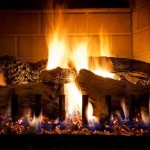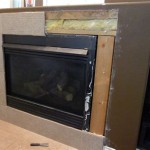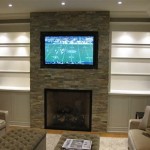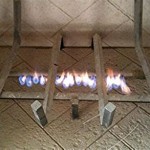Electric Fireplace Mounted On Brick Wall: A Comprehensive Guide
The allure of a fireplace has always resided in its ability to provide warmth, ambiance, and a focal point within a living space. Modern technology has provided alternatives to traditional wood-burning fireplaces, offering convenience and versatility. Among these alternatives, the electric fireplace stands out due to its ease of installation and minimal maintenance. When combined with the rustic charm of a brick wall, an electric fireplace mounted on brick creates a striking visual statement, blending classic and contemporary aesthetics.
This article will explore the considerations involved in mounting an electric fireplace on a brick wall, outlining the necessary steps, safety precautions, and design considerations to ensure a successful installation. Understanding the technical aspects, limitations, and potential challenges is crucial for achieving a safe and aesthetically pleasing result.
Before delving into the specifics of mounting, it’s essential to define what constitutes an electric fireplace. An electric fireplace is a heating appliance that simulates the look and feel of a traditional fireplace through the use of electric heating elements and visual effects, typically employing LED lighting to mimic the appearance of flames. These units do not require venting, making them suitable for a wide range of spaces. The heating capacity of an electric fireplace is generally measured in British Thermal Units (BTUs) or watts, allowing consumers to select a unit that provides adequate heat for the intended room size.
The primary appeal of an electric fireplace lies in its ease of installation and operation. Unlike wood-burning or gas fireplaces, electric models do not require a chimney, gas line, or complex venting system. This simplicity translates to lower installation costs and greater flexibility in terms of placement within a home. Furthermore, electric fireplaces are generally safer to operate, as they do not produce open flames or emit harmful gases. They often include safety features such as overheat protection and cool-to-the-touch surfaces, reducing the risk of burns or fires.
Brick walls, with their inherent texture and character, offer an ideal backdrop for an electric fireplace. The contrast between the smooth, modern lines of the fireplace and the rough, natural appearance of the brick creates visual interest and enhances the overall aesthetic. However, mounting an electric fireplace on a brick wall presents specific challenges that must be addressed to ensure a secure and stable installation.
Assessing the Brick Wall's Structural Integrity
The first and perhaps most crucial step in mounting an electric fireplace on a brick wall is to assess the structural integrity of the brickwork. Brick walls, particularly those in older homes, may exhibit signs of deterioration such as crumbling mortar, loose bricks, or cracks. These issues can compromise the wall's ability to support the weight of the fireplace, potentially leading to a dangerous situation.
A thorough visual inspection of the brick wall should be conducted to identify any signs of damage. Pay close attention to the mortar joints between the bricks, looking for areas where the mortar is crumbling or missing. Loose bricks should be re-mortared or replaced to ensure a solid foundation. Cracks in the brickwork, especially those that are wide or expanding, may indicate structural problems that require professional attention.
If the brick wall exhibits significant damage or structural concerns, it is advisable to consult a qualified mason or structural engineer before proceeding with the installation. They can assess the extent of the damage, recommend appropriate repairs, and advise on the suitability of the wall for mounting an electric fireplace. Ignoring structural issues can lead to a compromised installation and potential safety hazards.
In addition to the overall condition of the brickwork, it is also important to consider the type of brick used in the wall's construction. Some types of brick are more porous and less durable than others, which can affect their ability to grip fasteners and support weight. Soft or crumbling bricks may require specialized anchors or mounting techniques to ensure a secure attachment. If you are unsure about the type of brick used in your wall, consult with a building professional for guidance.
Finally, consider the thickness of the brick wall. Thinner brick walls may not be as strong as thicker walls and may be more susceptible to damage from drilling and anchoring. If the wall is particularly thin, it may be necessary to use reinforcement techniques, such as installing a backer board behind the fireplace, to distribute the weight and provide additional support.
Selecting the Appropriate Mounting Hardware
Choosing the right mounting hardware is paramount when installing an electric fireplace on a brick wall. The hardware must be capable of securely attaching the fireplace to the brickwork while distributing the weight evenly to prevent damage. Incorrectly selected or installed hardware can lead to the fireplace becoming loose, unstable, or even falling off the wall.
The most common type of mounting hardware used for brick walls is masonry anchors. These anchors are designed to expand or grip the inside of the drilled hole, providing a secure and reliable hold. Several types of masonry anchors are available, each with its own advantages and disadvantages. Sleeve anchors, wedge anchors, and concrete screws are all viable options, depending on the weight of the fireplace and the type of brick.
Sleeve anchors consist of a bolt surrounded by a sleeve that expands when the bolt is tightened. They are relatively easy to install and provide a strong hold in solid brick. Wedge anchors are similar to sleeve anchors, but they use a wedge-shaped clip to expand the anchor. They are typically used for heavier loads and offer excellent holding power.
Concrete screws, also known as Tapcon screws, are self-tapping screws that are designed to be driven directly into concrete or brick. They are a good option for lighter loads and are relatively easy to install. However, they may not be as strong as sleeve or wedge anchors in softer brick.
When selecting masonry anchors, it is essential to choose anchors that are appropriately sized for the weight of the electric fireplace. Consult the fireplace manufacturer's specifications to determine the weight of the unit and choose anchors that are rated to support at least that weight. It is also important to consider the thickness of the brick wall when selecting anchor length. The anchors should be long enough to penetrate deep into the brickwork, providing a secure hold.
In addition to masonry anchors, it may also be necessary to use washers and spacers to ensure a flush and stable mounting. Washers help to distribute the load of the fireplace over a larger area, preventing damage to the brickwork. Spacers can be used to create a gap between the fireplace and the wall, allowing for proper ventilation and preventing heat buildup.
Always follow the manufacturer's instructions when installing masonry anchors. Proper installation is crucial for ensuring a secure and reliable attachment. Use the correct drill bit size for the anchors and be careful not to over-tighten the anchors, which can damage the brickwork.
Electrical Considerations and Safety Procedures
Installing an electric fireplace involves dealing with electrical wiring, which requires adherence to safety procedures and compliance with local electrical codes. Incorrect wiring can lead to electrical shocks, fires, or damage to the fireplace. It is essential to take precautions and follow established safety guidelines to ensure a safe and reliable installation.
Before starting any electrical work, disconnect the power to the circuit that will be used to power the fireplace. This can be done by turning off the circuit breaker at the main electrical panel. Always double-check that the power is off by using a non-contact voltage tester to ensure that no electricity is flowing through the wires.
Electric fireplaces typically require a dedicated 120-volt or 240-volt circuit, depending on their heating capacity. Consult the fireplace manufacturer's specifications to determine the required voltage and amperage. If the existing electrical circuit is not adequate, it may be necessary to install a new circuit. This should be done by a qualified electrician.
When wiring the electric fireplace, use appropriately sized electrical wires and connectors. Follow the manufacturer's wiring diagram to ensure that the wires are connected correctly. Use wire strippers to remove the insulation from the wires and crimp connectors securely to the ends of the wires. Ensure that all connections are tight and secure.
Grounding the electric fireplace is essential for safety. The grounding wire provides a path for stray electrical current to flow back to the electrical panel, preventing electrical shocks. Connect the grounding wire to the grounding terminal on the fireplace and the grounding terminal in the electrical outlet.
After completing the electrical connections, double-check all the wiring to ensure that it is correct and secure. Use a multimeter to test for continuity and voltage. Once you are confident that the wiring is correct, turn the circuit breaker back on and test the fireplace to ensure that it is working properly.
It is highly recommended to hire a qualified electrician to perform the electrical work for an electric fireplace installation. Electricians are trained and experienced in electrical wiring and are familiar with local electrical codes. They can ensure that the installation is done safely and correctly, minimizing the risk of electrical hazards.
Finally, consider the placement of the electrical outlet in relation to the fireplace. The outlet should be easily accessible and should not be hidden behind the fireplace. This allows for easy access for maintenance and repairs. If necessary, install a new electrical outlet in a convenient location before mounting the fireplace.

Touchstone Sideline Elite 50 Inch Recessed Smart Electric Fireplace 80036 Home S Inc

Jayden Wall Hanging Electric Fireplace

Focal Point Atherstone Brick White Mdf Wall Mounted Electric Fire Suite

Electric Fireplace In A Brick Wall Premium Photo

Glitzhome 60 In Wall Mounted Electric Fireplace Black

Best 25 Wall Mount Electric Fireplace Ideas On Tv Reviews Fireplaces And

How To Install An Electric Fireplace Morton Stones

Electric Fireplace Gallery Touchstone Home S Inc

Simplifire Format 36 Electric Wall Mount Fireplace Sf Format36 Junction

Glitzhome Oak Plus 50 In L Black Recessed Wall Mounted Electric Fireplace With 9 Color Flames Faux Log And Crystal Decorated 2024200003 The Home Depot








